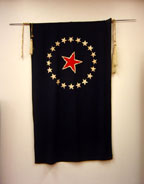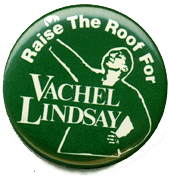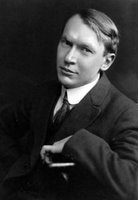It is portentous, and a thing of state
That here at midnight, in our little town
A mourning figure walks, and will not rest,
Near the court-house pacing up and down.
Or by his homestead, or in shadowed yards,
He lingers where his children used to play,
Or through the market, on the well-worn stones
He stalks until the dawn-stars burn away.
A bronzed, lank man! His suit of ancient black,
A famous high top-hat and plain worn shawl
Make him the quaint great fugure that men love,
The prairie-lawyer, master of us all.
He cannot sleep upon his hillside now.
He is among us: - as in times before!
And we who toss and lie awake for long
Breathe deep, and start, to see him pass the door.
His head is bowed. He thinks on men and kings.
Yea, when the sick world cries, how can he sleep?
Too many peasants fight, they know not why,
Too many homesteads in black terror weep.
The sins of all the war-lords burn his heart.
He sees the dreadnaughts scouring every main.
He carries on his shawl-wrapped shoulders now
The bitterness, the folly and the pain.
He cannot rest until a spirit-dawn
Shall come; --the shining hope of Europe free:
The league of sober folk, the Workers' Earth,
Bringing long peace to Cornland, Alp and Sea.
It breaks his heart that kings must murder still,
That all his hours of travail here for men
Seem yet in vain. And who shall bring white peace
That he may sleep upon his hill again?
August, 1914
Tuesday, January 31, 2006
ABRAHAM LINCOLN WALKS AT MIDNIGHT (In Springfield, Illinois)
Monday, January 30, 2006
The Municipal Flag of Springfield
 In 1916, Vachel Lindsay met with members of the Springfield Art Association and together they organized a contest for the design of the official municipal flag for Springfield. The SAA flag committee included former Illinois governor Richard Yates, reknowned Springfield architect George Helmle as well as my great-grandmother, Lyna Chase Souther.
In 1916, Vachel Lindsay met with members of the Springfield Art Association and together they organized a contest for the design of the official municipal flag for Springfield. The SAA flag committee included former Illinois governor Richard Yates, reknowned Springfield architect George Helmle as well as my great-grandmother, Lyna Chase Souther.Lindsay put up $100.00 as prize money for the winning design, shown here.
The flag's design became an integral component of New Springfield's geography in Lindsay's The Golden Book of Springfield, as this exerpt attests:
Lindsay describes the vast scale of the outer walls with gates at each of the five star-points located at Mason City, Warrenburg, Pana, Palmyra and Virginia, Illinois. The walls, according to Lindsay's narrative, were"...the path of white around the red star of Springfield is the map of our five-pointed system of double walls and within them a star-plan system of avenues."
"...built so long ago by Ralph Adams Cram!"The flag still flies proudly over Springfield. Lindsay said of the flag,
"Those that can unite under the flag of Springfield with joy can someday unite the world over, under the flag of mankind."
2018: The Millennial Year

March 1, 2018, Oak Ridge Cemetary...
There is a deep darkness, and time passing by without end, and shade. There is the fear of the moles that will not leave me alone, who make nests of alien dust, beneath my ribs. And my bones crumble through the century, like last years autumn leaves. Then there is, alternating with drouth, bitter frost. And roots wrap my heart and brain. And there is sleep.Vachel Lindsay describes his return to Springfield one hundred years in the future in his utopian novel, The Golden Book of Springfield.
Then a galloping and gay shrieking, away on the road, to the east of Oak Ridge! And though I am six feet beneath the ground the eyes of the soul are given me. I see the wonderful young horsewoman out on that Great Northwest Road and the ancient clay between me and that cavalcade turns to air and to light. And I am asking myself as the Girl Leader goes by like a meteor: "Am I coming up again through the earth as weed or flame or man? If I rise from this grave, I am coming but to praise her, if I may."
It's not too early to prepare for the Millennial Year, when Lindsay and the winged book are due to appear! It would be most appropriate to organize readings of the Golden Book on the dates and times and at many of the places mentioned therein.
Vachel Lindsay and Walled Towns

This one subject combines my family history with the life and work of Vachel Lindsay and the history of Springfield. It ties together The Vachel Lindsay Home State Historic Site and the Elijah Iles House in ways historians hadn't previously considered.
Below is my introduction to the transcription I made of Lindsay's annotations. I'll post the transcription itself elsewhere.
Sometime between February, 1920 and October, 1921, the poet Vachel Lindsay annotated a copy of Walled Towns by Ralph Adams Cram and inscribed it to Lyna Chase Souther, a socialite of Lindsay's hometown, Springfield, Illinois.
Cram was an important Gothic revival architect and a disciple of John Ruskin, the pre-eminent Victorian art critic who was also an important influence on Lindsay. Walled Towns, first published in 1919, proposes intentional communities surrounded by metaphorical walls keeping in local talent and keeping out the modernism and commercialism of the industrial age. Cram’s protest to the contrary notwithstanding, Walled Towns falls into the utopian genre.
Lindsay found much to agree with in Walled Towns, which appeared just at the time he was hammering out his own utopian novel, The Golden Book of Springfield. Areas of disagreement with Cram, however, provoked lively responses by the poet penned in the margins of the book in his lovely Spencerian hand. Lindsay's commentary provides insights into his thinking during this time and sheds light on some of the more obscure aspects of his Golden Book. Although Lindsay never mentioned The Golden Book in his Walled Towns annotations, the connection is obvious.
Lindsay intended his Golden Book to transform Springfield.
"You haven’t the least notion of the heart’s blood I am putting into The Golden Book," he wrote to Harriet Monroe, "I would certainly die for the book, if it would do the work I want it to do."
"This book seems to me to be the one thing that justifies my life," he wrote later.
Considering the many important changes that were occurring in Springfield and America while Lindsay was writing The Golden Book, anything must have seemed possible to him at the time. Springfield’s elite had recently commissioned a survey by the Russell Sage Foundation that prompted many social reforms and structural improvements for the city. With the "war to end all wars" just concluded, America embraced Prohibition and women’s suffrage. The country was poised to enter the Jazz Age with its Lost Generation while Lindsay desperately worked to steer things in the opposite direction. It is one of those tragic ironies that the Prohibition amendment which Lindsay himself had helped bring about - and hoped would redirect American culture - ultimately fostered the lawlessness and dissolution that characterized the Roaring Twenties.
Lindsay drew upon many sources for The Golden Book, not the least of which was his already prodigious body of poetry and the rich metaphorical language he developed in that work. John Ruskin, Edward Bellamy and Ralph Adams Cram were already important influences in his thinking and writing. Lindsay's great ambition in The Golden Book was to orchestrate these disparate elements into a cohesive whole. However, without the benefit of a thorough understanding of his literary parentage and his own particular metaphorical language, The Golden Book of Springfield can come across as hopeless nonsense. Lindsay’s writing often demands a fair degree of effort and indulgence from its readers, but The Golden Book of Springfield can strain even the patience of his most ardent devotees.
Lindsay's gift of his hand-annotated copy of Walled Towns to Lyna Souther - with the request that she share the book among her friends in the Springfield Art Association - apparently was intended to enlighten and influence the prominent people and community leaders of Springfield. The "debate," as Lindsay dubbed it, between Cram and himself might help him lay the groundwork for acceptance of his Golden Book in the Springfield community and attest to his earnestness in transforming the town.
Lyna Chase Souther, a talented landscape painter herself, and the sister of Woodstock founder, Frank Swift Chase, was an obvious ally to enlist in this cause. Lindsay had recently collaborated with Souther and the Art Association in the creation of Springfield’s municipal flag. The flag became a prominent component of The Golden Book and fit well with Lindsay's and Cram's shared penchant for civic heraldry and pageantry.
If Lindsay saw Lyna Souther as part of the solution in Springfield, he must have seen her husband, Latham Souther, as part of the problem. It is apparent from his letters that he saw Latham, a banker who happened to be the trust officer of his father’s estate, as the very embodiment of the main street businessman he had waged war against and felt oppressed by throughout his career. Souther was described in one of the congratulatory volumes of local biography and history as one of Springfield's "representative men." As such, he appears to have represented the side of Springfield that resisted Lindsay's ideas the most. It is not very likely that Latham would have reacted any differently to The Golden Book than would have George Babbitt himself.
Although utopias such as Edward Bellamy's Looking Backward 2000 - 1887 had been a very popular literary form in the past – the science fiction of their day - and had inspired much discussion, the critics and the public at large failed even to acknowledge The Golden Book of Springfield when it appeared in 1920. As a vehicle for rallying Springfield and America to his vision, it was a tragic failure for Lindsay.
The copy of Walled Towns inscribed to Lyna Souther, the annotations of which are transcribed here, now resides in the Sangamon Valley Collection in Springfield, a gift of her daughter, Betty McMinn.
Included with the book in the collection are two loose letters, one from Lyna's friend, Charles Ridgely, returning the book to her in 1923 along with a 1921 letter from Ralph Adams Cram to Ridgely saying he would like to see Lindsay's annotations.
Cram never saw this annotated copy, but mentioned in his letter that he had heard from his friend Stephen Graham that Lindsay had distributed twenty or thirty copies of the book. Cram referred to Lyna's copy of Walled Towns as "the annotated copy" in his letter, but Lindsay apparently handed out many such annotated copies to friends and neighbors over the years. Lindsay later referred to these as "illuminated" copies.
Read the transcripition here.
Biographical
Inaugural message
 This space is dedicated to discussion of the life and work of a foremost American poet, Vachel Lindsay (1879-1931), the Prairie Troubador.
This space is dedicated to discussion of the life and work of a foremost American poet, Vachel Lindsay (1879-1931), the Prairie Troubador.As a Lindsay researcher and enthusiast, it's my pleasure to be your host and to welcome you to share your comments on the many posts that will appear here in the future.
Lindsay's contibution to American letters is too important for him to be forgotten. Let's harness the energy of the blogosphere to bring new listeners to Vachel's songs and spirit. Let this be our new Village Magazine!
